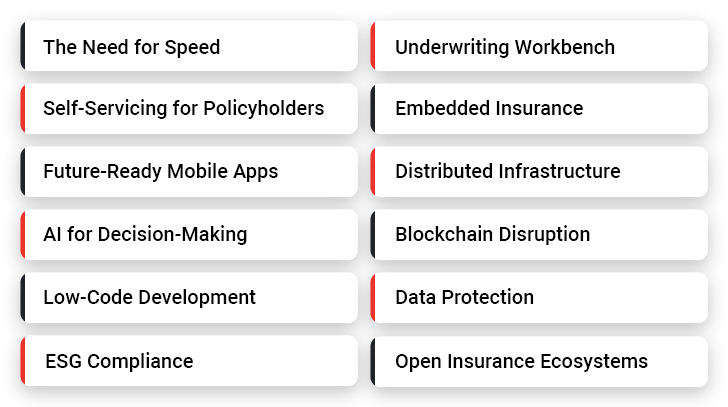The insurance sector is a late bloomer when it comes to the adoption of cutting-edge technologies. Until the digital revolution picked pace, most of the players in the Insurance sector were content with legacy systems. However, with the rapid proliferation of new-age technologies such as Artificial Intelligence (AI) and the Internet of Things (IoT), the industrial landscape is evolving and the incumbents are making strategies to enable the digital transformation of their firms. The adoption of any new trends in insurance technology should be a top-down exercise and C-suite must lead the effort. From gauging penetration of the new age insurance tech solutions vis-a-vis change in consumer behavior, the CIO office needs to run the show and usher in the era of digital transformation in the organization.
Top 12 Industry Trends in Insurance Technology

Here are 12 ways through which CIOs can harness new technology in the insurance industry to reinvigorate their organization’s digital strategies while driving customer acquisition:
1. The Need for Speed
In this rapidly changing world, the insurance industry is under pressure to keep up with the pace of change. New entrants in the form of digital-first insurers and innovative start-ups to the market are offering new products and services at a much faster rate than incumbent insurers. This means that incumbents need to move faster in order to stay relevant. This has cultivated a shift in the mindset among insurance leaders and experts, as the need to innovate is becoming apparent to everyone involved.
Therefore, the right strategy for non-life insurers is knowing the customers holistically and crafting the products and services to match their expectations and needs on digital platforms as well. Their marketing strategies should position their value proposition appropriately to the tech-savvy audience as well.
The industry has been shifting from a conservative and legacy system-driven into an increasingly innovation-focused, digital culture. The insurers want to head towards more innovation, better customer and employee experience, increased agility, and innovative applications of existing technologies to age-old insurance problems such as risk-assessment claims processing and policy sales. Therefore, now we will see a lot of insurers modernizing their legacy systems and applications to become more future-ready.
2. Rise of Self-Servicing for Policyholders
About 81% of consumers want self-servicing options, and that goes for insurance policyholders too. They now expect to be able to do more for themselves without having to pick up the phone and speak to a customer service representative of the insurer. As customers turn more tech-savvy, they are turning to insurance technology trends as a medium to purchase policies, manage policies, settle payments, raise claims, etc. While transferring the power and control into the hands of the consumer would vastly improve the customer experience, it will also benefit businesses by lowering customer acquisition costs, elevating insurance agent productivity, increasing customer retention, expediting claims processing, and cementing brand value and position. However, to extend such an option, insurance companies would have to be digitally mature enough to build platform-agnostic apps and portals to facilitate customer requests.
3. Making Mobile Apps Streamlined and Future-ready
Carriers are using Mobile Apps to acquire, service, and retain policyholders, and advances that drive value for consumers help position carriers as long-term, vital partners. With Mobile Apps making it easier to access customer location and vital data, pitching customized premiums has become easier. Simultaneously, on-the-field interactions have become more efficient with Relationship Managers (RMs) offering better clarity into the product’s features through tablets.
Nevertheless, in the present-day scenario, it is not about just being mobile. It is about rich features, engaging UI, and hyper-personalized experiences. Prospective buyers are short on time while searching for the desired product in the portfolio, they want recommendations auto-populated with easy access to human interaction through chat or call.
This year, it will no longer be about leveraging the apps as a supplementary mode for accessing only core policy information, but they can integrate telematics tools and offer streamlined claims servicing will help drive policyholder engagement.
For a CIO, it is important to oversee the performance of the app on parameters such as user engagement, data security, cross-device compatibility, and conversion. In the future, apps will be the single point of contact with your prospects, and the entire transaction from purchase to claim settlement would be done through the app itself. Hence, CIOs should lead mobile strategies with the vision of an app-exclusive future.
Dynamically Grow with the Latest Insurance Technology Solution
4. Embracing of Gen AI Gaining Momentum
The demand for personalized insurance offerings is creating a rise for usage-based insurance as a primary business model. Therefore, Artificial Intelligence (AI) as a technology driver is shaping one of the most critical insurance industry trends. As per a study by McKinsey, by 2030, Artificial Intelligence will overhaul all aspects of the insurance industry. With the advent of intelligent machines, bio-sensors, and deep-learning algorithms in ordinary objects; the Insurance sector is bound for a major shift from ‘pay for damage’ to ‘prevent damage’. While this shift in the landscape might seem slow and happen in the background, the simultaneous emergence of IoT and AI in public space will make the contemporary way of claim processing obsolete and open up the road to claims process automation. As a result, CIOs must make strategies and adopt the recent trends in the insurance sector to prepare the organization for the proliferation of data from connected devices.
The integration of Generative AI in insurance further amplifies the transformative impact on the industry. In time to come, insurance businesses that have invested in advanced data analytics will implement Gen AI to enhance the capabilities of their existing AI systems.
Few questions that CIOs need to lead the organization to find answers to are as follows:
- Is your workforce ready for upskilling?
- Is your organization financially ready to adopt cognitive insurance technology?
- How will risk be defined in the age of wearables?
- How can Gen AI be leveraged to augment existing datasets?
5. Low-Code Development For Faster Go-to-market
While insurers are pressing the acceleration pedal to achieve digitalization at the eleventh hour, low-code platforms have been helping them enable faster digital transformations by enabling them to build applications and portals faster. Since their advent, low-code platforms have been continuously growing in popularity due to the fact that they solve some burning issues facing IT teams. No-code tools amplify overstretched internal resources, reduce backlogs, and improve productivity. In fact, Gartner revealed that the market share of low-code solutions has grown by 22.6%, while traditional high-end custom development has declined by 23%.
The most crucial quality that makes Low-code insurance platforms extremely attractive is accelerated time to market for new digital applications and products compared with traditional development projects. They allow business stakeholders to update and manage apps and software using an intuitive, user-friendly drag-and-drop functionality. With moderate or even elementary app and software experience, insurers will be able to quickly implement new and different UI features that customers demand, in a fraction of the time usually required.
Accelerate Your Insurance Digital Transformation Journey
6. Better Environmental, Social, and Governance (ESG) Compliance
The insurance sector is witnessing unique issues that can be linked to Environmental, Social, and Governance (ESG) criteria. Insurers are not only evaluated by their sustainability reports but also by their initiatives on how they are continuously addressing carbon emissions, taking steps to diversify their workforce, and increasing transparency in their governance structures. Governments and governmental bodies are also making it legally binding for companies, insurance included, to transition to the low-carbon economy and manage climate-related risks.
On the other hand, insurers are themselves realizing the impact of ESG on businesses and their functioning. About 85% of global insurers believe that investments (91%), risk and internal audit (90%), and underwriting (88%) would greatly transform along with their ESG commitments. As a result, the current and future insurance industry trends would focus on ESG liabilities as a way of conducting business. They will engage with the desired authorities to determine the best ways to meet ESG requirements and understand their implications.
7. Increasing Admiration of Underwriting Workbench
Centralization of data and business processes is one of the greatest advantages of the digitalization of economies. Amongst the various insurance dashboards that are going to make an appearance in the years to come, the underwriting workbench would be one of the most instrumental tech inclusions.
As the name indicates, the underwriting workbench is a centralized workspace that contains an underwriter’s most valuable digital tools and supports the whole underwriting process. The resulting end-to-end underwriting control panel streamlines workflows and conserves time and energy while elevating employee and customer experiences. At the same time, this new technology in the insurance industry also paves way for integrated and collaborative working. It will undoubtedly become more than just a nice-to-have for individuals transitioning to a digital way of working with the usage of AI and machine learning.
8. Embedded Insurance Gaining More Momentum
“Embedded Insurance”, one of the current technology trends in the insurance industry, banks on “meeting customers where they are” concept. This means it can typically be purchased during the buying process for another product (For example, personal auto insurance bought at a car dealership or travel insurance offered through an air ticket checkout process). This is one of the key digital trends in the insurance industry that not only boosts the affordability and accessibility of insurance services but also helps improve customer engagement and risk removal in the process.
Insurance carriers will seek opportunities to find new and innovative areas to launch embedded insurance products. Hence, there will be a greater number of partnerships between product and insurance companies in the coming years to result in greater market penetration.
9. Heading Towards Distributed Infrastructure
With various field agents and in-office policy managers, the insurance industry has been operating in a distributed manner since its inception. However, all players and stakeholders were gradually being brought to the same plane thanks to technological intervention. Companies that were yet to embrace such a business model or had glaring gaps in their systems were pushed to streamline everything during the pandemic. With this background, the latest trends in the insurance industry would be a refinement of this strategy. We would be seeing core business systems migrating to the cloud and strongly coupled with different insurance technology tools and platforms for a digitally-native insurance ecosystem. This will help insurance companies quickly launch new products and create improved customer service.
10. Brace for Blockchain Disruption
The Insurance Sector is an easy target for tech-savvy fraudsters. With the main premise of fraud detection and risk prevention, Blockchain technology is the natural candidate for deployment in the Insurance industry. Issuance of Insurance policies through smart contracts and encryption of medical records will make the operations secure and efficient, apart from bringing transparency between insurers and reinsurers.
Blockchain Insurance Industry Initiative (B3i), the collaboration of global insurers and reinsurers, has the likes of Allianz as its stakeholder and is involved in building Blockchain apps for the industry. When bigger players adopt Blockchain in their mainstream operations, it is imperative for medium and small players to follow the technology trends in the insurance industry. CIOs should keep a tab on Blockchain penetration, as it is likely to disrupt the Insurance landscape soon.
11. Keep the Data Secure
Insurance Carriers have access to highly-sensitive customer information, making them prone to cyber-attacks. The stakes are even higher because the industry traditionally runs on trust. Each technology update involves migration to a newer platform and business-unit-wide learning, exposing information to potential threats. Even a short-term attack, where attackers compromise a single system can detrimentally impact the brand reputation and increase customer attrition. While data-security measures such as Intrusion Detection Systems and Intrusion Prevention Systems are evolving, attackers are also honing their skills. To keep a step ahead, preemptive measures such as periodic security audits, contingency plans to mitigate risk, and security upskilling are required.
CIOs need to allocate adequate resources to keep data secure, impede breaches, and maintain a strong accountability system for robust security. To attract new customers, the promise of data security is probably the most understated offering with far-reaching repercussions.
12. The Surge of Open Insurance Ecosystems
Cloud-based digital ecosystems are one of the insurance industry trends that are rapidly gaining traction. Since they are hosted on the cloud, it makes it easier for insurers to connect their own offerings with those of other service providers. It enables insurers to set themselves apart from the competition and develop innovative products that are tailored to meet the needs of customers. It is expected that the insurance industry will leverage digital ecosystems and embrace open insurance models. Characterized by agility, flexibility, and end-to-end processes, these platforms will soon become key to staying competitive. The adoption of open insurance not only fosters a conducive environment for embedded insurance but also enables small and medium-sized insurers to explore and capitalize on embedding insurance in their offerings.
Concluding Thoughts
The above latest trends in the insurance industry are being constantly adopted across the globe to improve services and streamline businesses. To keep up with these insurance industry trends, insurance businesses can partner with an insurance technology company. Implementing scalable and agile insurance software solutions can reduce operational costs by preventing fraud and automating servicing, thereby giving more time to insurance agents to acquire and maintain business.
Case in Focus
A multi-line insurer, headquartered in the US, had a homegrown legacy system. The insurer was struggling to manage various transactions and processes on the in-house setup. We helped the insurer embark on their modernization journey and accelerate innovation. To know more, refer to the complete case study.






